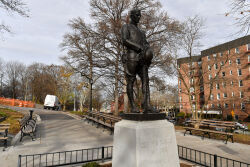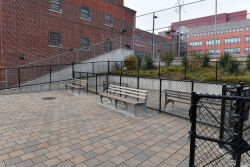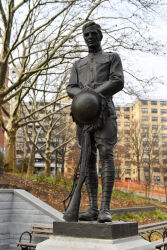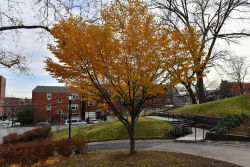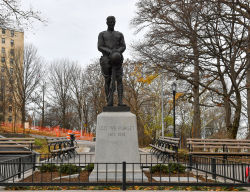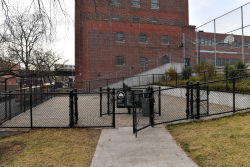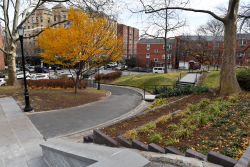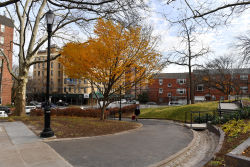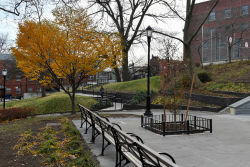Doughboy Park
Doughboy Park
What was here before?
The Town of Newtown acquired this land in 1893 as a play area for P.S. 11. It passed into the City of New York’s ownership in 1898, when Newtown and other Queens municipalities were consolidated into the New York City. An adjacent park property was once the estate of Woodside civic leader and businessman Louis Windmuller.
How did this site become a park?
The land was eventually deemed too steep and overgrown for children’s use and was assigned to NYC Parks in 1957, and the new park opened the following year. The site was transformed from a children’s play area into a sitting area for adults, in keeping with the dignity of the park’s doughboy monument. A naturally wooded section provided shade for park patrons. Although the park was named in 1971, the bronze and granite monument has stood on the site since 1923.
Before the statue was erected, local soldiers gathered here at the “mustering ground” before departing to fight in World War I. Ten men who left from this site died in combat. The Returning Soldier, and later dubbed The Woodside Doughboy, the poignant monument by Burt Johnson was erected by the Woodside Community Council in remembrance of the local men and women who served in World War I.
Funded by public subscription, the statue was dedicated on Memorial Day, May 30, 1923, and since then community members have gathered at the monument every Memorial Day for patriotic ceremonies. In 1928, the American Federation of Arts selected the Woodside Doughboy as the best war memorial of its kind.
The doughboy sculpture was conserved in 1990, and the surrounding plaza renovated with new seating and greenery in 2001. Additional markers listing local World War I casualties, key WWI military battles, and a memorial marker to those community members lost on 9/11 have been placed in the vicinity over time. A park restoration project completed in 2021 further improved the monument plaza with bluestone paving, removal of high fences, increased seating, new lighting, and planting beds.
What is this park named for?
The derivation of the term doughboy remains in question. It was first used by the British in the late 18th and early 19th centuries to describe soldiers and sailors. In the United States, the nickname was coined during the Mexican-American War (1846–1848), and was widely popularized during World War I (1914–1918) to refer to infantrymen. After the war, in which Americans saw combat in 1917-18, numerous communities commissioned doughboy statues to honor local war heroes. The Woodside Doughboy is one of eight such statues erected in New York City’s parks.
Check out your park's Vital Signs
Clean & Safe
Green & Resilient
Empowered & Engaged Users
Share your feedback or learn more about how this park is part of a
Vital Park System

